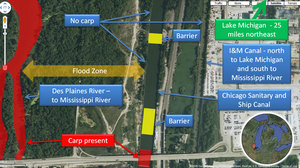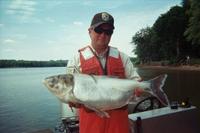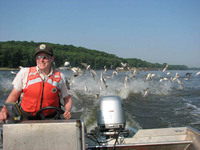Invasive Asian carp one flood away from Great Lakes
Advocates for the Great Lakes at the National Wildlife Federation are worried that all of the work to restore the Great Lakes could come to nothing if immediate action is not taken to keep Asian carp from invading Lake Michigan.

Map courtesy of the Alliance for the Great Lakes
One flood is all it will take to merge the waters of the Des Plaines and the nearby Chicago Sanitary and Ship Canal -- allowing the invasive carp direct access to the Lakes. This is not a far-fetched scenario — flooding merged the two waters in 2008 and 2007.
Asian carp and the Great Lakes: An Explosive Combination
An Asian carp invasion would likely decimate the Great Lakes.

Photo by the U.S. Fish and Wildlife Service
The carp are voracious eaters and consume the plankton at the bottom of the food chain. Where Asian carp invade, native fish are left without food and the ecosystem is drastically changed. In parts of the Illinois River where the carp have already invaded, nine out of 10 fish are Asian carp. The weight of native fishes lessened and many commercial fishing operations are failing.
Given the shear size of the Great Lakes and the fact that they are located at a similar latitude as the Asian carp's native home, but with no natural predators - the population of the invasive carp could easily explode if allowed to enter the Great Lakes.
What are Asian carp?
"Asian carp" refers to multiple species of carp, including the silver, bighead, and grass carp. The non-native carp species were brought to the United States to clean algae out of catfish ponds in the 1970's. By the 1980's, some carp had escaped fish farms and began to be seen in open waters in the Mississippi River basin. They have been moving north ever since - wreaking havoc on rivers and lakes.

Photo by the U.S. Fish and Wildlife Service
What's to be done?
Great Lakes advocates are urging that a barrier must be built immediately on the low, narrow strip of land between the potentially carp-infested Des Plaines River and the Chicago Sanitary and Ship Canal. Temporary fixes, including sandbags or an earthen berm are necessary to keep Des Plaines waters and carp out of the Great Lakes in the coming weeks and months.
Fortunately, Congress just approved funding and authorization for the Army Corps of Engineers to take emergency action to protect the Great Lakes from invasive species. However, that is no guarantee that a barrier will be constructed in time - before the next flood.
To learn more about the Asian carp and invasive species solutions, visit the Great Lakes Regional Center.
Jennifer Janssen is a contributor from the Great Lakes Regional Center of the National Wildlife Federation. She writes about connecting with nature, supporting solutions to climate change and protecting the Great Lakes. She can be reached at janssenj@nwf.org.


Comments
Jennifer Janssen
Thu, Nov 5, 2009 : 10:14 a.m.
Hi Wolverine3660 - The Asian carp are moving up the Mississippi River from lakes in the south where they were intentionally introduced to control weeds. (I bet that there are now a lot of folks saying "oops" over that.) It is illegal to possess live Asian carp, and there is concern that live fish could be introduced into the Great Lakes if the carp are being transported and sold alive. That's not to say that commercial fishing and sales of Asian carp isn't a good use of the fish (so long as they are not alive) -- the carp are sought after in Asia and perhaps the US could develop a taste for them! Ballast water actually is an unlikely vector for Asian carp -- though in general is the number one method that invasive species are transported into the Great Lakes. In terms of Asian carp, the biggest problem that we need to address (asap) is the various places in which the Mississippi River network is artificially connected to the Great Lakes. Thanks for your question!
theodynus
Thu, Nov 5, 2009 : 8:50 a.m.
@Wolverine3660: The answer is in the article.
Wolverine3660
Thu, Nov 5, 2009 : 7:55 a.m.
Jennifer- where are the Asian Carp coming from? Are they trapped in ship's ballast tanks, or are illegal carp sales in Asian grocery stores and fish stores the problem? If I remember correctly the US Fish and Wildlife Service and the DNR raided the big Asian store on Washtenaw, and seized a lot of their illegally imported live Carp.
Jennifer Janssen
Wed, Nov 4, 2009 : 3:07 p.m.
Karen, I agree. Definitely terrifying -- not sure whether the carp flying out of the water towards boaters' faces or eating everything in sight is more scary! If you want to urge the U.S. Corps of Engineers to get moving on keeping them out of the Great Lakes, we have an action alert at www.nwf.org/greatlakes.
KarenH
Wed, Nov 4, 2009 : 2:59 p.m.
Fascinating and terrifying.